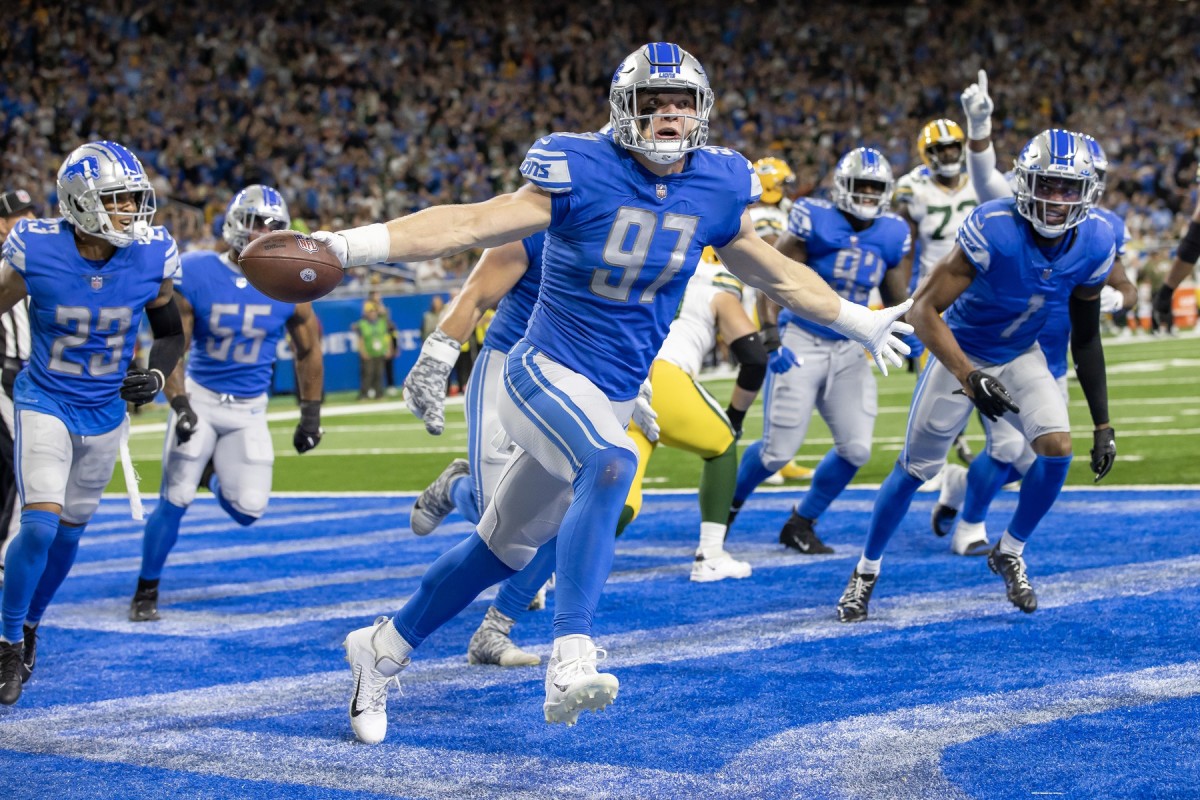New York Giants Week 11: First Look at Detroit Lions Defense
The New York Giants are within spitting distance of a playoff berth but have the fourth-hardest remaining strength of schedule. This week, they take on the Detroit Lions, who are on pace to have the eighth-worst defense in NFL history in terms of yards per game.
Let's break down what the Giants might be seeing Sunday.
Personnel
Much pressure comes with being the second overall pick in the NFL Draft, as Giants fans know with Saquon Barkley, but Aidan Hutchinson has handled it great. The former Wolverine has had an inconsistent start to his career production-wise, but he’s easily the best defender in this Lions front.
Coming out of college, I thought of Hutchinson as an edge defender with a high floor-- he’s got a full arsenal of pass-rushing moves, and he knows when to use them; he just needs to work on consistently winning with them.
So far, Hutchinson’s been the best pass-rusher for the Lions with 28 pressures, the only Lion above 13 this season. Hutchinson’s six sacks have come in just three games, as he had one game with three, two, and one sack - but the pressures have come consistently.
As a run defender, Hutchinson has 19 stops for a gain of three or less - tied with Alex Anzalone for the most on the team.
In recent weeks, Josh Paschal had taken over the starting role opposite Hutchinson before suffering a knee injury vs. the Bears this past week. Paschal should be back in the starting lineup this weekend.
Paschal isn’t a world-eating end, but he’s been consistently reliable dating back to college. In his limited time this season, Paschal’s generated nine pressures, giving him the fifth-most pressures on the team in just 110 pass-rush snaps.
On the interior, Alim McNeill and Isaiah Buggs are the biggest contributors. After playing a rotational role last season, McNeill was always expected to be a starter on this defensive line.
McNeill has shown flashes this season, picking up a season-high four pressures against the Minnesota Vikings in Week 3, but he hasn’t been able to put it together consistently yet. As a run defender, he’s been reliable as far as not giving up gap responsibility, but he’s yet to make splash plays there.
Buggs stepped into the starting role after Levi Onwuzurike was placed on injured reserve just before the season started. Buggs is a rotational defensive tackle talent-wise, but because of the Onwuzurike injury, Buggs has played more snaps this season than in the three years of his career combined.
As a pass-rusher, Buggs is practically non-existent, failing to generate pressure with any sort of consistency. Buggs has struggled more this season as a run defender than he previously had, likely because his consistent playing limits him from going 100% on every snap as he did as a rotational player.
Alex Anzalone leads the way for the Lions at linebacker. He’s also played more snaps than anyone else on this defense, with 580 of 614 possible snaps. With the scheme change, Anzalone’s role has changed in 2022, and he’s played considerably better than in 2021.
Anzalone isn’t playing great, but he’s improved this season. Working alongside him for most of the season has been rookie sixth-round pick Malcolm Rodriguez, who was a Hard Knocks darling during the preseason.
Rodriguez missed this past week against the Chicago Bears with an elbow injury but was questionable at game time, so he may be good to go. Rodriguez has had an up-and-down rookie season, but it looks very likely that sooner than later, he’ll be the primary linebacker on this Lions team.
In the secondary, Jeff Okudah has been the only consistent starter on the outside, with a revolving door of Amani Oruwariye, Jerry Jacobs, and Mike Hughes. Okudah was praised as a can’t-miss corner prospect in the 2020 NFL Draft and had struggled early on in his career, but 2022 seems to be the season where he’s turned it around.
In coverage, Okudah’s been targeted the most on the Lions with 40 targets, although it’s hard to use that against him, considering he’s the only corner that’s started and played most of the snaps. On those 40 targets, Okudah’s allowed 28 completions for 401 yards, one touchdown, and one interception, a pick-six last week off of Justin Fields.
At safety, the Lions have been rolling with DeShon Elliott and Kerby Joseph. Elliott is in his first season in Detroit after spending the first three years of his career in Baltimore. Elliott’s been used all over the defensive backfield and has thrived in his new role, compared to when he primarily played the single-high in Wink Martindale’s Ravens defense.
Joseph was a third-round pick in the 2022 NFL Draft, making him yet another rookie that’s a major contributor to the Lions defense. Joseph has exceeded expectations after being thrust into the starting lineup following Tracy Walker being placed on injured reserve with a torn Achilles.
Joseph’s played almost exclusively as the deep safety and has taken his fair share of lumps, giving up two touchdowns and 85 yards last week. For the most part, though, Joseph has been as reliable as you could hope for as a rookie that wasn’t supposed to be a starter.

Scheme
During the 2021 season, the Lions operated out primarily a 3-4 defensive front with three down linemen and four stand-up linebackers. For 2022, they’ve shifted more towards a 4-3 front with four down linemen and three stand-up linebackers.
Most people understand that, and most people understand that regardless of the number shown, there are typically four players on the line of scrimmage with at least one stand-up linebacker in a 3-4 playing as an edge rusher. The Lions are in a transitional stage where they’ll operate out of a 3-4 and 4-3, while filling their roster with better schemes for the 4-3.
What makes the Lions defense fun is that regardless of whether they show a 3-4 or a 4-3, their defensive personnel doesn’t change. Aidan Hutchinson will usually be one of the edge defenders, whether he has his hand up or in the dirt, and whoever is playing on the opposite side of the defensive line will do the same.
This aggressive defensive scheme shows no hesitation to use off-ball linebackers or defensive backs as blitzers to help generate a pass rush. That’s a conceptually-sound strategy, but it means nothing if you don’t execute it properly.
The Lions blitz on 28.2% of their defensive snaps but only generate pressure 19.2% of the time. That means they’re the 11th-most blitz-happy defense in the NFL but rank just 24th in pressure percentage.
The Lions have primarily used linebackers as their additional rushers, but they show no hesitation in bringing a cornerback or safety. In recent weeks, Will Harris has shifted from rotational player to starting nickel defender and has been used as a pass-rusher on 10.6% of his defensive snaps since taking over the role.
Coverage-wise, the Lions played a ton of man coverage early in the season until their 48-45 loss to the Seattle Seahawks in week four. Following that loss, head coach Dan Campbell said he would sit down with defensive coordinator Aaron Glenn to determine what changes needed to be made to get this defense right.
From week five on, the Lions started playing more zone coverage and started giving up fewer big plays. The Lions defense is still bad and porous, but it’s improved despite dealing with more injuries than they had early in the season.
What This Means for the Giants
You know how every week, the strategy is pretty much run the ball with Saquon Barkley, run the ball with Daniel Jones, don’t give the ball to the opponent? Well, that hasn’t changed.
The Giants once again benefit from playing against a horrible run defense that allowed running backs to demolish them on the ground. This season, the Lions have the fifth-worst yards per game allowed to running backs, allowing 113.3 rushing yards per game just to running backs.
Of course, if a team is that bad at stopping running backs, they have to be better at containing quarterbacks on the ground, right? Wrong. The Lions are the worst team as far as giving up quarterback rushing yards per game, with 41.3 yards per game.
If there was ever a game where Brian Daboll pulls Daniel Jones aside and tells him to run the ball and throw it deep (if there’s time), it’s this week. The Lions have given up fewer big plays than earlier in the season, but they still allow deep completions almost at will.
More realistically, expect quick passes to the flats for Jones with the Lions being so aggressive as blitzers. Last week, they blitzed Justin Fields on 46.2 percent of his dropbacks, and with Jones’ mobility, I would expect to see a similar blitz rate this week.
Final Thoughts
This is another game where the Giants could run the ball and look good offensively due to a weak defensive opponent. Taking care of the ball is just as important as it always is, but the approach that the Giants have taken all season should continue to work in their favor this week.
Join the Giants Country Community
- Sign up for our FREE digest newsletter
- Follow and like us on Facebook
- Submit your questions for our mailbag
- Check out the new Giants Country YouTube Channel.
- Listen and subscribe to the daily LockedOn Giants podcast.
- Subscribe and like the LockedOn Giants YouTube Channel
- Sign up for our FREE message board forums
- Get your Giants tickets today from SI Tickets!
